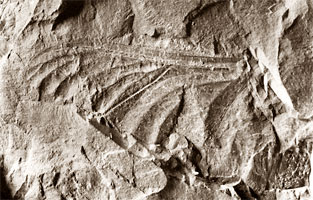Paleodictyopteroidea



This tree diagram shows the relationships between several groups of organisms.
The root of the current tree connects the organisms featured in this tree to their containing group and the rest of the Tree of Life. The basal branching point in the tree represents the ancestor of the other groups in the tree. This ancestor diversified over time into several descendent subgroups, which are represented as internal nodes and terminal taxa to the right.

You can click on the root to travel down the Tree of Life all the way to the root of all Life, and you can click on the names of descendent subgroups to travel up the Tree of Life all the way to individual species.
For more information on ToL tree formatting, please see Interpreting the Tree or Classification. To learn more about phylogenetic trees, please visit our Phylogenetic Biology pages.
close boxCharacteristics
Palaeodictyopteroid insects share a unique mouthpart morphology. Their clypeus is much enlarged, and they have a distinctive beak formed by five elongate, stiff elements.Discussion of Phylogenetic Relationships
Like most Paleozoic insects, paleodictyopteroids are known mostly from fossil wings. Due to a scarcity of suitable characters for phylogenetic analysis, the relationships between the subgroups have not been elucidated. Diaphanopterodea, Megasecoptera, and Permothemistida each show distinctive venational patterns and are therefore likely to be monophyletic groups; however, Paleodictyoptera is probably paraphyletic with respect to the other three subgroups (Grimaldi 2001).References
Carpenter, F. M. 1992. Superclass Hexapoda. Volume 3 Part R, Arthropoda 4 of Treatise on Invertebrate Paleontology. Boulder, Colorado, Geological Society of America.
Grimaldi, D. 2001. Insect evolutionary history from Handlirsch to Hennig, and beyond. Journal of Paleontology 75:1152-1160.
Kukalová-Peck, J. and C. Braukmann. 1990. Wing folding in pterygote insects, and the oldest Diaphanopterodea from the early Late Carbonferous of West Germany. Canadian Journal of Zoology 68:1104-1111.
Handlirsch, A. 1904. Les Insectes houillers de la Belgique. Memoires du Musée Royal d'Histoire Naturelle de Belgique 3:3-20.
Labandeira, C. C., and J. J. Sepkoski, jr. 1993. Insect diversity in the fossil record. Science 261:310–315.
About This Page
Page copyright © 2002
All Rights Reserved.
Citing this page:
Tree of Life Web Project. 2002. Paleodictyopteroidea. Version 01 January 2002 (temporary). http://tolweb.org/Paleodictyopteroidea/8264/2002.01.01 in The Tree of Life Web Project, http://tolweb.org/








 Go to quick links
Go to quick search
Go to navigation for this section of the ToL site
Go to detailed links for the ToL site
Go to quick links
Go to quick search
Go to navigation for this section of the ToL site
Go to detailed links for the ToL site